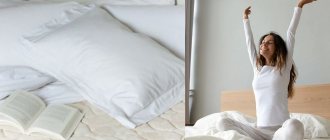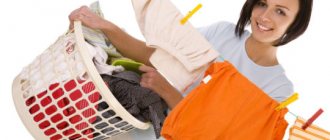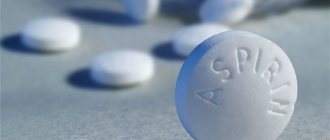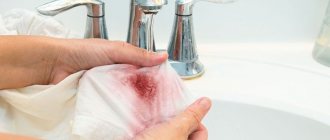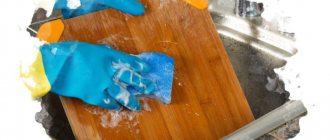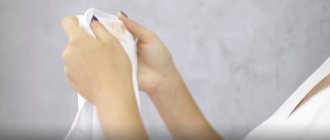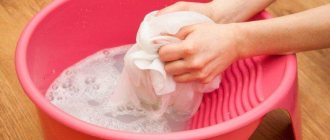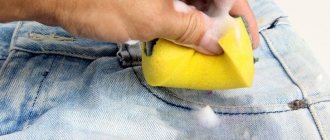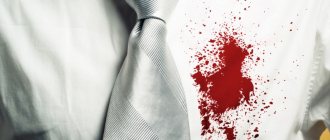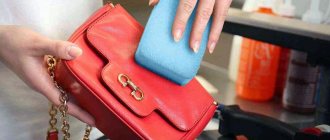Children are little “energizers,” so their clothes get stained all the time. For example, infants very often smear porridge or puree on their T-shirts. Children of kindergarten age most often get their shorts and pants dirty with sand or grass, and schoolchildren get stains on their clothes during too active games.
How to properly remove these types of stains?
Is it possible to remove old stains? And how can you make the process of cleaning clothing items as safe as possible? Attention! For washing children's clothes, use only those detergents that are marked “0+”. In addition, always wash your child's clothes separately from your adult's.
How to quickly remove stains from puree, apples and juice?
The difficulty of washing children's clothes is that for this process you can only use safe products that will not cause allergies:
- Salt. Sprinkle fresh stains generously with fine table salt, change it several times, and then wash in lukewarm water.
- Laundry soap and salt. Suitable for washing old stains. Wet the product in cool water, soap it generously with laundry soap and place it in a plastic bag for two hours. Then wash in warm water and rinse with fine salt.
- Laundry soap and milk. To remove stains from delicate items, dilute soap shavings in warm milk and apply this mixture to the stain, leave for a couple of hours and wash.
Assessment of the problem and adequate choice of a way out of the current situation
Stains on the surface of children's clothes most often appear during eating.
All sorts of contamination from fresh vegetables and fruits, homemade and store-bought juices very often occur on children's clothing. For certain groups of stains, different cleaning methods and means are provided.
In general, the arsenal of cleaning “materials” looks like this:
- baby powder;
- lemon acid;
- potassium permanganate;
- milk;
- bleach;
- hydrogen peroxide;
- soda;
- salt;
- vinegar;
- laundry soap.
To remove stains, you can also purchase special concentrated children's bleaches in the store. There are no restrictions or preferences for a particular brand in terms of effectiveness and safety.
All items presented on store shelves in the Russian Federation comply with domestic and international quality standards.
How to remove banana stains?
Children usually love bananas, but ripe fruit leaves unsightly yellow marks on clothes.
You can get rid of them using secrets well known to experienced housewives:
- Cut a fresh lemon and rub the pulp on the problem area, wash it in warm water after an hour.
- Pour some acetic acid onto a cotton swab and rub the stain. You can mix fine salt and baking soda in equal proportions, then sprinkle the desired area generously.
After this, it is better to wash the product in warm water with washing gel or soap shavings.
Be sure to read:
How to wash iodine: effective ways to remove stains from fabrics, what not to use
Laundry soap
Many experienced housewives use proven laundry soap to remove old stains from children's clothes at home. Despite its pungent odor and high alkali content in the composition, it is safe for washing. The only thing worth considering is that soap should never come into contact with the baby’s delicate skin. It's perfect for removing applesauce, fruit juice, and pumpkin stains from clothes.
How to remove stains from light and white fabric?
Yellow stains often remain on baby sheets or diapers, which are difficult to remove with normal washing.
Therefore, you can use well-proven folk remedies:
- Mix baking soda and water in equal doses and apply to the stain , vigorously rubbing the mixture into the fabric. Leave for a quarter of an hour and then wash the product.
- Dilute 5 g of soda ash in 1 liter of hot water , then add this solution to the laundry tub and fill with 5 liters of cold water. Place dirty clothes there, bring to a boil and boil for 10-15 minutes.
- Place 2 tbsp in a bucket of cold water. l baby powder and 5-6 grains of potassium permanganate. Place items that need bleaching into this solution and leave overnight. In the morning, lightly wash, rinse and dry in the sun.
Do I need to wash baby clothes before the maternity hospital?
It is better to buy and prepare clothes for a newborn before the birth. Don't forget about bedding, diapers and other accessories for your baby. They also need to be washed before use.
Be sure to buy a laundry detergent specifically designed for children's clothes. You need to use baby powder to wash not only your baby’s diapers and underwear, but also your clothes that you plan to take with you to the hospital.
Wash all items at the maximum water temperature allowed for specific types of fabric. Don't forget to use the extra rinse mode. After washing, be sure to iron the items from the front and back sides.
When packing baby supplies, try to place them separately in the laundry according to their intended purpose.
Removing stains from colored clothes
Washing colored items is complicated by the fact that they cannot be boiled and no mixtures can be applied to problem areas so as not to spoil the design on the fabric.
If you are not against using household chemicals, then purchase a special stain remover (or powders) with o and follow the instructions strictly.
If you want to use improvised means, then:
- Prepare an alcohol solution (100 g of medical alcohol per 2 liters of warm water). Soak the product in this solution for two to three hours and then rinse.
- Take 2 liters of water, 50 g of hydrogen peroxide and 10 g of washing powder, prepare a solution. Soak the items for an hour and a half, then wash and rinse.
What else can you do to get rid of fruit stains?
A washing machine, powders and bleaches are not always at hand, and you don’t want to turn a beautiful product into a rag, so use the “old-fashioned” method:
- Pour lukewarm water into a small basin, add 2 teaspoons of salt, soda and ammonia.
- Stir the solution thoroughly and then pour in 1 tsp. peroxide and leave the soiled clothes for half an hour or an hour. If the stain is fresh, it will come off without a trace.
Read more ► How to wash iodine: effective ways to remove stains from fabrics, what not to use
Removing old yellowness
Good bleaches are expensive and can cause an allergic reaction. There is an old proven method that will significantly improve the appearance of the product.
Of course, old white will not become snow-white, but it will be much fresher and whiter:
- Mix 2 tbsp. l. vegetable oil with the same amount of washing powder and bleach, add 15 g of baking soda, pour boiling water.
- Immerse the laundry there and boil for no more than 20 minutes.
- Machine wash and rinse several times.
Be sure to read:
How to wash lipstick: effective folk and chemical remedies, can it be removed from white fabric?
Small stains on white shirts can be removed using a hydrogen peroxide solution. Dissolve 50 g of peroxide in 5 liters of water and put the laundry there for an hour. After this, rinse.
Various contaminants
To effectively remove stains from children's clothing, it is necessary to specifically use products for a specific type of stain.
Removing fresh grease stains
Grease stains on clothes cause a lot of trouble.
How to deal with them:
- Cover the newly placed stain with fine salt or starch , and then wash this area with laundry soap.
- A solution of salt and ammonia in equal parts removes greasy stains from fabric well. Soak the item overnight and then wash.
- Pour rubbing alcohol onto a cotton swab and rub the stained area for a couple of minutes. Wash the item in warm water with baking soda added.
- Old grease stains on clothes can be removed using hot potato starch. Cover the problem area with starch and rub it in carefully with a cotton pad, then wipe it off and cover it with new starch. After cleaning, wash the item in warm water with laundry soap and rinse in a blue solution.
Chocolate problem
Children's favorite chocolate causes many problems for mothers who want to see their kids neat and beautifully dressed.
But stains from this delicacy can also be removed using improvised means:
- Salt and ammonia. Dissolve a small amount of ammonia in a glass of warm water and soak the product. First, cover the problem area with fine salt for about five minutes.
- Washing gel. The use of washing gel will allow you to completely remove fresh stains from cocoa. Dissolve it in cool water with the addition of baking soda, soak the item for an hour and a half and rub the problem area.
Be sure to read:
How to remove rust from clothes: methods of removal from white and colored items
Traces of blood
If you accidentally drop blood on a light-colored item, you need to act quickly:
- Pour some hydrogen peroxide onto the area and rub it a little, then wash it in cool water.
- A woolen item can be cleaned with an aspirin solution. Dissolve the tablet in a glass of warm water, apply to the stain and scrub with a soft brush.
- Moisten an old bloody stain with a solution of 9% vinegar and leave for a quarter of an hour, then wash.
- Prepare a solution of ammonia (10 g of solution per 200 g of water), use it to erase the blood stain.
- Mix baking soda, salt and washing powder in equal parts. Wash your clothes by hand or in a washing machine.
Ironing baby clothes
Please note that in the first two to three weeks of a child’s life (until the umbilical wound heals), clothes and diapers must be ironed both on the front and back sides. In this case, always set the maximum possible temperature and steaming mode.
After the first month of a baby's life, clothes can be ironed on one side. Some young mothers stop ironing things altogether, citing the fact that ironing affects the breathability of the material, and excessive sterility blocks the normal development of the immune system. Others, in turn, do not stop using the iron, since ironing gives clothes a more presentable appearance, and the steaming function helps remove harmful bacteria and microorganisms.
Children's clothing must be washed immediately after purchase and before going to the maternity hospital. You can wash it by hand or in a washing machine, following the basic rules and subtleties. You need to choose a detergent that is specifically designed for washing children's clothing and does not contain phosphates or other impurities.
What to do if nothing helps
The modern chemical industry offers a huge range of household chemicals. But not everyone trusts such compounds: they cause allergies and sometimes do not give the expected effect.
Before you begin, you need to determine the type of fabric and the origin of the stain:
- Stains from red wine, fresh berries and juices can be cleaned using a mixture of egg yolk and glycerin. The mixture should be applied to the problem area, left for one and a half to two hours and washed with laundry soap.
- You can remove stains from light-colored items made from delicate fabrics with a mixture of 10 parts white laundry soap, 2 parts turpentine and 1 part ammonia. First, the product needs to be soaked with detergent for several hours, and then the problem areas should be generously moistened with the prepared mixture and washed in a machine.
- Blood or chocolate stains can be smeared with a paste of potato starch and water. The applied mixture should dry, and then it should be washed off with warm water and soap.
What detergents should not be used when washing children's clothes?
All manufacturers of baby powder convince us that it is safe and harmless. Potentially dangerous components can be contained in any powder, even the most recommended one. Before purchasing, it is advisable to familiarize yourself with the composition. It should not contain:
- Phosphates - they are added to the powder to soften water and better wash away dirt. Upon contact with children's skin they cause irritation: dermatitis, eczema, chemical burns.
- To make the powder foam better, surfactants are added to it. Without them, powders would be practically useless in the fight against grease stains. The substances are toxic to people of all ages: if they enter the body, they provoke the development of cancerous tumors.
- Baby powder should not have any odor or fragrance content. No aromas of lemon or alpine freshness - they cause an allergic reaction from skin irritation to swelling of the respiratory tract.
Liquid or capsule laundry detergents have become popular in the last couple of years. They are less toxic because they are almost completely rinsed out of things.
